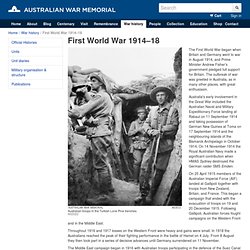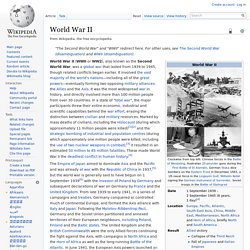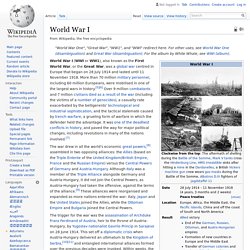

The Long, Long Trail. Timeline of World War II. First World War 1914–18. Australian troops in the Turkish Lone Pine trenchesA02022 The First World War began when Britain and Germany went to war in August 1914, and Prime Minister Andrew Fisher's government pledged full support for Britain.

The outbreak of war was greeted in Australia, as in many other places, with great enthusiasm. Australia's early involvement in the Great War included the Australian Naval and Military Expeditionary Force landing at Rabaul on 11 September 1914 and taking possession of German New Guinea at Toma on 17 September 1914 and the neighbouring islands of the Bismarck Archipelago in October 1914. On 14 November 1914 the Royal Australian Navy made a significant contribution when HMAS Sydney destroyed the German raider SMS Emden. On 25 April 1915 members of the Australian Imperial Force (AIF) landed at Gallipoli together with troops from New Zealand, Britain, and France. Throughout 1916 and 1917 losses on the Western Front were heavy and gains were small. Sources and further reading: J. World War II. World War II (WWII or WW2), also known as the Second World War, was a global war that lasted from 1939 to 1945, though related conflicts began earlier.

WW1 memories: my grandfather's story. It all begins so cheerfully, in gorgeous weather, with the troops itching to join the great adventure abroad.

As the 2nd Battalion of the King's Own Yorkshire Light Infantry sets sail from Dublin for Le Havre on an old cargo ship, the SS Buteshire, on 14 August 1914, a chorus of hoots and sirens fills the riverside air as a large crowd sends them noisily on their way. It feels, in the words of a young medical officer on board, "like the realisation of the dream of every soldier". When they head out into the open sea and are sailing towards Land's End, a message is read out to all those on deck from King George V. "You are leaving home to fight for the safety and honour of my Empire," he tells them. "I pray God to bless you and guard you and bring you back victorious. " "Hell would be a tame word to describe what we went through," he writes of five dreadful days in October.
The farm survives the German fire of 27 October, but the next day at noon it starts up again. World War II — History.com Articles, Video, Pictures and Facts. Participants in World War I. Map of the World showing the participants in World War I.

Those fighting on the side of the Triple Entente (at one point or another) are depicted in green, the Central Powers in orange, and neutral countries in grey. This is a list of countries that participated in World War I, sorted by alphabetical order. World War I casualties. The total number of military and civilian casualties in World War I was over 37 million.

There were over 16 million deaths and 20 million wounded ranking it among the deadliest conflicts in human history. The total number of deaths includes about 10 million military personnel and about 7 million civilians. The Entente Powers (also known as the Allies) lost about 6 million soldiers while the Central Powers lost about 4 million. At least 2 million died from diseases and 6 million went missing, presumed dead. World War I. World War I (WWI or WW1), also known as the First World War, or the Great War, was a global war centred in Europe that began on 28 July 1914 and lasted until 11 November 1918.

More than 70 million military personnel, including 60 million Europeans, were mobilised in one of the largest wars in history. Over 9 million combatants and 7 million civilians died as a result of the war (including the victims of a number of genocides), a casualty rate exacerbated by the belligerents' technological and industrial sophistication, and the tactical stalemate caused by trench warfare, a grueling form of warfare in which the defender held the advantage. World War II English Worksheets For Comprehension. Neville Chamberlain. History - World War Two: Summary Outline of Key Events. Primary History - World War 2. Ww2-bomb-found-during-construction-1. Emergency situations personnel work at the site where an unexploded bomb, of 'great destruction power' dating back to World War II, was found.

Related Stories Belgrade - An unexploded bomb of “great destruction power” dating back to Wold War 2 was found in downtown Belgrade and removed on Sunday for controlled detonation, the government said. The one-ton German bomb containing 620 kilograms of explosives was found during construction works in the capital's central area of Dorcol, forcing the authorities to evacuate some 20 inhabitants from a nearby building. “The bomb had a great destruction power and if it had exploded it would have blown up the entire area,” Serbian Prime Minister Ivica Dacic told reporters. The device was typical of the type dropped by Heinkel He 111 bombers during World War 2, Dacic said. The Nazi airforce heavily bombed Belgrade on April 6, 1941 at the beginning of a four-year occupation.
WW1 U-boat wreckage visible in River Medway. World War 2. Timeline. Schools - Primary History. World war images. WWII Eastern Front 1941-45 Slideshow. World War I — History.com Articles, Video, Pictures and Facts. Recounts from World War Two.